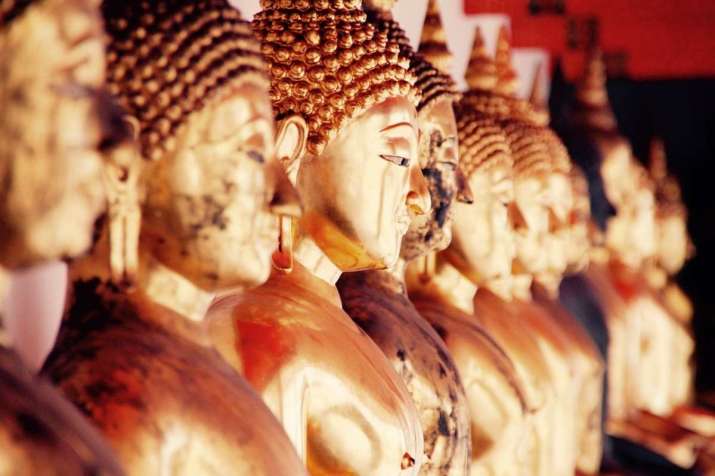FEATURES|COLUMNS|Theravada Teachings
Nine Qualities of the Buddha

While I was ordained as a monk for the period of Vassa, the rains retreat, I was given the task of understanding Pali chants. While it is beneficial to chant and to listen to the words in Pali, it is even more illuminating to be able to understand what the words actually mean.
Let me explain by giving a straightforward example. In Pali we may chant the following:
Iti pi so Bhagava, araham,
samma-sambuddho, vijja-carana-sampanno,
sugato, lokavidu, anuttaro-purisa-damma-sarathi,
sattha-deva-manussanam, buddho, bhagava’ti.
Which translated means:
Such indeed is the Blessed One, worthy, fully self-enlightened, endowed with knowledge and conduct, fortunate, knower of the worlds, the incomparable tamer of trainable men, teacher of gods and men, enlightened, and blessed.
There are likely devotees who have been chanting about these nine qualities of the Buddha in the Pali language again and again, perhaps even for many years, without fully understanding what the words signify. So let’s take a closer look at these oft-chanted lines and explicate their meaning in a little more detail.
One common example might be the Pali word araham, which means one who has eradicated the defilements. By constantly reflecting on this quality of the Buddha, araham, we may gradually gain insight and merit.
Another example would be the word, buddho. When the word buddho is repeated, continuously, over a long period, one may benefit from the magical tonality made in the sound of “buddho, buddho, buddho . . .” in the ancient Magadha dialect known as Pali.
As with poetry and poetics, we may, firstly, explicate a term’s primary meaning and then expand upon the word’s implications, delving into ever-wider and/or deeper levels. Allow me to illustrate in more detail:
The above chant lists nine important qualities of the Buddha. In Pali, these nine qualities are:
1. araham
2. samma-sambuddho
3. vijja-carana-sampanno
4. sugato
5. lokavidu
6. anuttaro-purisa-dhamma-sarathi
7. sattha-deva-manussanam
8. buddho
9. bhagava
What at first seems to be quite a short verse turns out to contain a lot of meaning. The qualities of the Buddha indicated in the meanings of these nine Pali words are indeed vast:
Araham
Araham means that the Buddha had eradicated and become free from all defilements. Defilements in plain language means bad thoughts, bad reactions, such as anger, anxiety, hatred, frustration, stress, depression, ignorance, jealousy, gossip, attachment, dogmatism, and so on. The Buddha had rid himself of all these and so inspires us with His qualities. Because He is free from all defilements so He is araham. While repeating the word araham, one continues to reflect on this quality. The words arahant and arahat come from the same etymological background and share a similar meaning with araham.
Samma-sambuddho
This means to discover, to understand, and to fully comprehend the Four Noble Truths of suffering, the origin of suffering, the cessation of suffering, and the Noble Eightfold Path, without any aid from a teacher. The Four Noble Truths that we have been taught and thought about, we can continue to reflect upon until we understanding them fully.
Vijja-carana-sampano
Vijja-carana-sampano is knowledge and conduct, or theory and practice; the Buddha is endowed with both. He says as He acts and He does what He says. When you see things like this, you realize how great is the quality of vijja-carana-sampano the Buddha possesses and how valuable are all His qualities. Some people know the theory but do not practice it.
Sugato
Sugato is a great speaker who is adept in the art of choosing the right words, saying them at the right time, and in such a way as will benefit the listener. The Buddha was a master of that.
Another meaning of sugato is that the Buddha walks the best path to reach His goal—the path leading to freedom from suffering (dukkha). When the Buddha meditates and a pain arises, He observes the pain without increasing dukkha, whereas the majority of people personalize pain or suffering and misperceive it through attachment and pride (mana). The Buddha avoided this path of misconstruing things and followed the right path. He chose to deal with things in the right way that freed Him from suffering. The Buddha, being a sugata, walked the path of freedom and freed Himself from mental suffering.

Lokavidu
Lokavidu is the person who knows about the world. What do we mean by loka? There are six worlds: the seeing world, the hearing world, the smelling world, the tasting world, the touching world, and the thinking world. There are no other worlds than these six. The Buddha understands how they arise and cease. He knows how clashes and harmony arise in this world. He knows why people can be trapped in them or be freed from them. That is why He is called lokavidu. You are in harmony with the world only when you know about it and live accordingly, accepting as it is.
Anuttaro-purisa-dhamma-sarathi
Anuttaro-purisa-dhamma-sarathi means that the Buddha is the best teacher who can bring the wayward back into the fold. The Buddha can make people understand with either just one sentence or a whole series of talks, like the time He gave His first sermon to the five ascetics. We should reflect on this quality of the Buddha whenever we experience problems teaching or explaining things to children. How capable the Buddha is in these things!
Satta-deva-manussanam
Satta-deva-manussanam—the teacher and leader of devas and men. Not knowing more than the Buddha or even knowing as much as the Buddha did, we struggle to understand even a tiny bit of what He said in His sermons, and this is in spite of having many learned monks teaching us. He was the satta-deva-manussanam. There were many that became the Buddha’s followers. Even after He passed away, there are many like us who regard the Buddha as their teacher and leader.
Buddho
Buddho is the person who knows the Four Noble Truths. This is similar to samma-sambuddho, which emphasizes the fact that the Buddha discovered the Four Noble Truths by Himself. Buddho simply emphasizes the fact that he knows it well. He was the Awakened One, who awakened from ignorance and delusion.
Bhagava
Bhagava is a person endowed with special powers. The merits the Buddha had accumulated are much more than those of others and this is also why He was called bhagava. The merits are acts of sharing, ethical morality, patience, renunciation, wisdom, diligence, truthfulness, determination, loving-kindness, and equanimity. He perfected these to the most difficult and advanced level. He shared not only material things in His past lives but also His limbs and life.
Conclusion
When we consider the above explanations, we realize how helpful it can be to understand the meaning of the Pali terms when we chant. When the chanting is over, as we are return to out kutis, we carry with us the broader and deeper meanings elaborated and echoed in the words of the Buddha.
References
Phra Rajyanvisith (Hon.D.). 2011. Traditional Pali Chanting Book in English. The National Coordination Center of Provincial Meditation Institutes of Thailand.
Related features from Buddhistdoor Global
Changing Perceptions: Reflections on the View of Theravada as the “Lesser Vehicle”
Nurturing Pali Studies: Chiara Neri’s Translation of a Medieval Sri Lankan Text
A Path to Peace: The Engaged Buddhism of Venerable Tajay Bongsa














